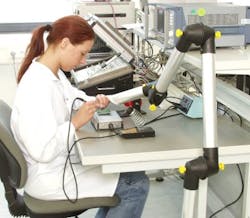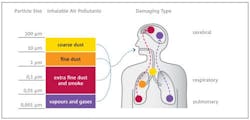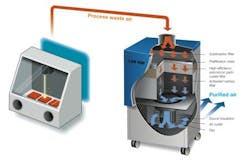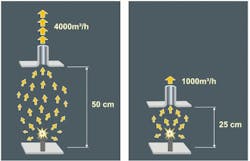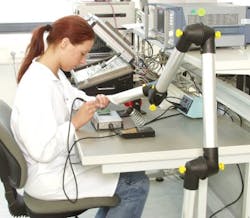Extraction and filtration technology is more important than expected
Occupational health and safety in manufacturing companies have become increasingly important in recent years. Today, it should be seen as a part of the job rather than an annoyance. Manufacturing processes have gained in complexity, and resulting pollutants have become smaller and particularly more exotic. "From chipping come chips" is a popular saying, but the chips cannot be seen with the naked eye any longer since particle size of resulting dust and smoke has arrived in the nano range.
Pollutants of any size always affect humans, machines, and the environment. In addition to social and human aspects, a high sickness-absence rate of employees has adverse economic effects on a company just like malfunctioning machines due to pollutions. Maintenance expenses, rework, and loss of reputation and falling demand are the predominant adverse effects.
These factors lead to a rising demand for extraction and filtration technology, which reliably protects equipment and employee health, and furthermore takes account of changing process parameters.
By now, extraction and filtration technology covers a wide range of airborne substances. Nearly all processes to be found in the manufacturing industry are supported. From interconnection and separation technologies, to surface processing such as drilling, sintering, and milling, and to the utilization of fluxes or production processes such as 3D printing or rapid prototyping by means of laser, soldering, and gluing—all these processes generate harmful substances that might show extreme impact on health (FIGURE 1).
Laser smoke as an example of hazardous substances
Lasers are increasingly utilized in metal and plastics processing, such as in drilling, welding, cutting, engraving, sintering, etc. In metal processing, dusts containing heavy metals are released that may accumulate in the human body. During processing of alloyed metals, contained substances such as nickel, cobalt, and chromium are released. The pyrolysis of organic substances may generate dioxins or hydrogen chloride. Moreover, laser smoke contains fine dust that may, at worst, lead to respiratory diseases, cardiovascular problems, and an increased cancer risk.
Apart from bad quality of work due to permanent smoke and odor emissions, machines may be affected or damaged due to pollution and chemical reactions of their products. In particular, in the case of finest-precision mechanical works, each kind of impact by particles must be avoided (FIGURE 2).Legal provision
In many countries, there are clear regulations and laws to remove hazardous substances in breathing air. In Germany, for example, there is the Ordinance on Hazardous Substances, Technical Instructions for Air Quality Control, and Technical Rules for Hazardous Substances. Those standards require that "produced dusts must be completely captured and safely disposed…"
There is a four-level protection concept, ranging from minimizing dangerous substances (level 1), via substitution of hazardous substances and (use of) extraction devices (level 2), and closed systems and access limitations (level 3), to demarcation of risk areas and respective limitation in clean air return. In addition to the regulation on contaminant capture by closed and open systems, it is specified that dusts and gases must be filtered on a high degree (>99.95%).
Users of air filtration plants do not necessarily have to know all these regulations; however, vendors of extraction and filtration systems must know them in detail. They need up-to-date expert knowledge on the full range, from checking the medium to be filtered, particle size distribution and characteristics (adhesive, subliming etc.), up to tests of hazardous substances and flammability.
Clean air return is not regulated by law, but strengthens economic and ecological acceptance and self-interest. From the point of view of healthy air balance and heat-loss avoidance, extraction and filtration technology should be utilized in the best way possible.
What extraction and filtration technology must accomplish
What do users of extraction and filtration systems expect? Primarily, such systems must meet various requirements to guarantee minimal maintenance effort, health protection, and high quality of work. This includes:
Capturing hazardous substances
The capture of contaminants is regulated by law in various countries. These regulations determine risk categories for specific hazardous substances; e.g., in terms of fire and explosion risks or in types of health-damaging effects (carcinogenic, mutagenic, or toxic for reproduction).
Demand for particle capture at the point of origin makes sense, because:
- Large quantities of pollutants can be captured;
- There are relatively low capture efforts;
- Good filtration opportunities are given; and
- Low energy consumption is possible.
Conclusion
Extraction and filtration in industrial environments goes far beyond the vacuum cleaner principle. It is not just a case of dirt removal, but to eliminate hazardous substances in the air that may cause more than a dust allergy. The precondition for users is knowledge about their materials and processes. Vendors of extraction and filtration technology propose a suitable system. They have expert knowledge concerning legal regulations and chemical and physical characteristics of the media to be extracted and filtered. They finally adapt a system for air purification suitable to the operating conditions in a facility.
About the Author
Stefan Meissner
Corporate Communications
Stefan Meissner is in corporate communications at ULT (Löbau, Germany).
